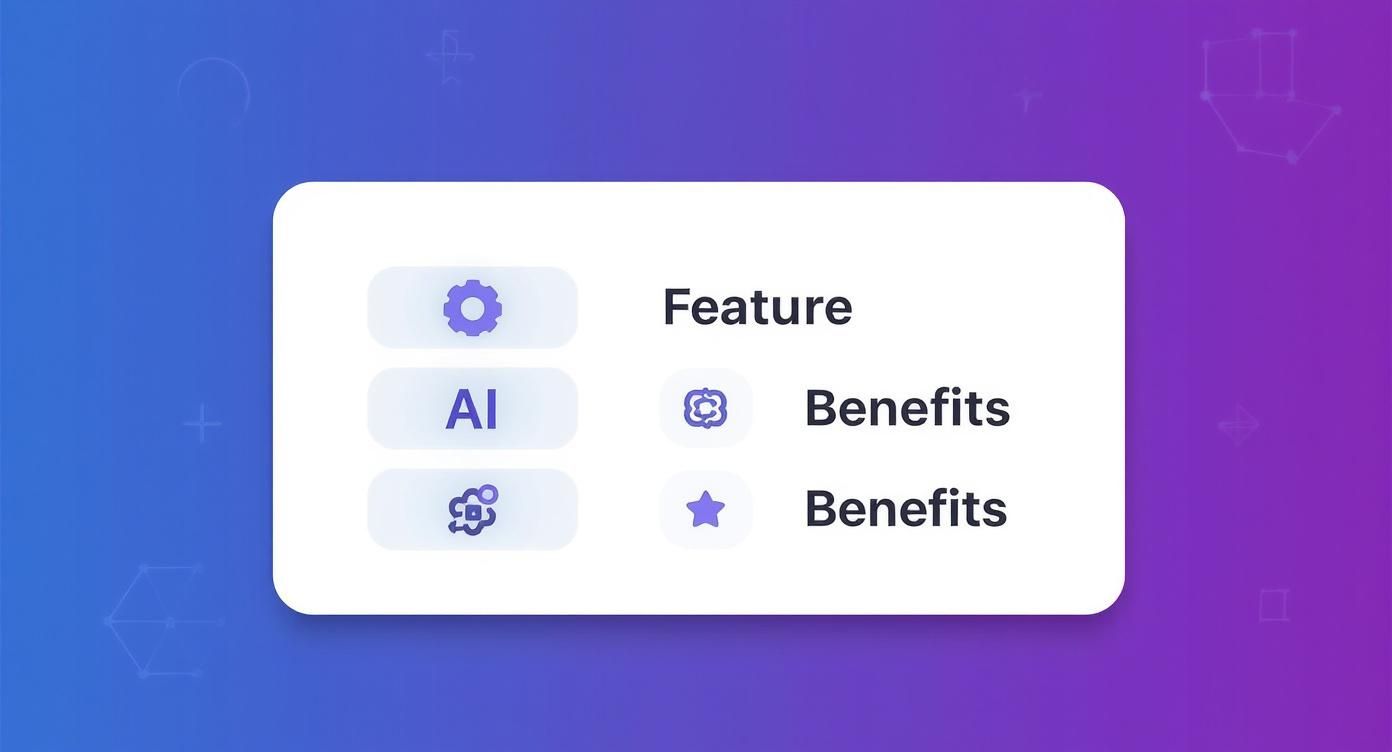
Writing a product description that sells goes far beyond a simple list of features. The real challenge for marketers and creators is tapping into the emotions and benefits your product brings to a customer's life. A truly great description tells a story, solves a real-world problem, and connects with the buyer on a personal level, turning your product page into a 24/7 salesperson. This guide offers a clear, step-by-step process to transform your product descriptions from flat feature lists into powerful conversion tools that resonate with your target audience and drive sales.
Why Most Product Descriptions Fail to Convert

Staring at a blank product page can be intimidating. Many brands pour time and effort into crafting what they think is the perfect description, only to see it completely miss the mark. The problem usually boils down to a fundamental disconnect: a gap between what the brand thinks is important and what a customer actually cares about. Most descriptions are company-centric, not customer-centric. They're packed with technical specs, assuming dry details are persuasive. But seasoned marketers know: people don't buy products; they buy better versions of themselves. They're buying feelings, solutions, and a transformation.
The Feature vs. Benefit Trap
One of the most common mistakes is leading with features instead of benefits. A feature is a fact about the product. A benefit is how that feature makes the customer’s life better. For instance, "hand-sewn sequins" is a feature. "Channel your inner Beyoncé at your next event" is a benefit. See the difference? The second one creates an emotional hook that cold, hard facts just can't match.
Brands fall into this trap for a few common reasons:
- They're too close to the product. Creators are understandably proud of the craftsmanship, but customers are laser-focused on one question: "What's in it for me?"
- It feels safer. Listing features is objective. Digging into a customer's emotions requires a much deeper understanding of their pain points and dreams.
- They lack a clear brand voice. Without a defined personality, descriptions become generic, forgettable, and fail to stand out in a crowded market.
To break out of these ruts, you need to start treating your product pages like high-conversion assets. A fantastic guide on Amazon listing optimization is a great place to start, as its principles apply to almost any e-commerce platform. This mindset shift is foundational to mastering conversion copywriting, where prioritizing benefits helps you build a genuine connection that drives sales.
Pinpointing Your Customer's True Motivation

Before a single word of your product description is written, you need to know exactly who you're talking to. The best descriptions don’t shout to a faceless crowd; they whisper to a single person because they mirror that person's unique struggles and hidden desires. A detailed customer persona isn't just a "nice-to-have"—it's your most powerful tool. Many marketers stop at the basics like age and location, but the real gold is in the psychographics—the why behind what they do. What's keeping them up at night? If you want to write a product description that truly connects, you need to know these answers cold.
Moving Beyond Demographics to Uncover Psychographics
To really get inside your customer's head, you have to become a bit of a digital detective. Your mission is to find out where your audience hangs out online and just listen. This is where you’ll find the raw, unfiltered language that turns generic copy into something that feels deeply personal.
So, where do you start digging?
- Competitor Reviews: Go straight to the one-star and five-star reviews for similar products. The one-star reviews are a goldmine for pain points, while the five-star reviews tell you all about the emotional wins your customers are craving.
- Online Forums and Communities: Places like Reddit, Facebook Groups, or niche industry forums are overflowing with candid conversations. Pay close attention to the specific phrases people use to describe their problems.
- Customer Surveys: Sometimes, the best way to get an answer is to just ask. A simple survey with questions like, "What was the one big problem you hoped our product would solve?" can provide incredibly clear insights.
This isn't just about grabbing data points; it’s about building genuine empathy to create a clear picture of your ideal buyer.
Building a Persona That Guides Your Writing
Once you've done your homework, pull all that research into a practical customer persona. This isn’t some formal document you file away; think of it as a living guide for every word you write. A great persona helps you answer the single most important question in copywriting: "What's in it for them?" It forces you to shift your focus from your product's features to your customer's life.
For instance, a marketing manager shopping for project management software isn't really buying "task tracking." They're buying "peace of mind." They're buying "fewer pointless meetings." They're buying "the confidence to actually hit their deadlines." When you know this, you can write a description that speaks directly to those core desires. You make your customer feel seen, heard, and completely understood. And that's when they click "buy."
👉 Try MediaWorkbench.ai for free – generate AI content and schedule your posts in one place!
Using AI to Find Your Product's Core Message
Once you’ve nailed down who your customer is, the next big hurdle is turning technical specs into a story that connects with them. The real magic happens when you uncover your product's core message—the emotional "why" behind the "what." This all comes down to defining your unique value proposition (UVP) and constantly answering the customer's silent question: "What's in it for me?" This used to mean long brainstorming sessions. Now, AI can jump in as your creative sidekick.
From Features to Feelings with AI Prompts
Think about a common feature, like a backpack made from "water-resistant nylon." The generic description just states the fact. But with AI, you can dig into the feeling that feature creates. For instance, a marketer could pop this into MediaWorkbench.ai: "Brainstorm 10 benefit-driven ways to describe 'water-resistant nylon' for a professional commuter's backpack."
Suddenly, you get angles you might not have thought of:
- Peace of mind on rainy days: "Walk into your meeting with confidence, knowing your laptop and important documents are completely protected from unexpected downpours."
- Durability and longevity: "Invest in a bag built to handle the daily grind, rain or shine, so you're not replacing it next season."
- Effortless maintenance: "Spills and splashes wipe away in seconds, keeping your bag looking sharp and professional with zero effort."
We’ve shifted the focus from a simple material spec to a real, tangible improvement in someone's life.
Brainstorming Your Unique Value Proposition
Your UVP is the promise you make to your customers. It’s what makes you the obvious choice over everyone else. AI is brilliant for sharpening this message by analyzing your product features against your target audience's biggest frustrations. Exploring the top AI tools for ecommerce can make this process even smoother. Feed MediaWorkbench.ai your product details, competitor info, and customer persona, then ask it to generate five distinct UVPs. This simple exercise can uncover powerful angles. Our guide on the best AI tools for content creation shows you even more ways to fold these assistants into your workflow.
Designing Descriptions for Maximum Readability
A brilliant message is useless if it’s buried in a wall of text. People shopping online don't read; they scan. If your product description looks like a novel, they’ll click away before you ever get a chance to make your case. Designing for readability isn't about "dumbing down" your content. It’s about respecting your customer's time and making it incredibly easy for them to find the information they need to say "yes." This means short paragraphs, clear headings, and bullet points that get right to the good stuff. When you learn how to write a product description that is effortlessly scannable, the buying decision feels just as effortless.
Crafting a Magnetic Opening Line
Your first sentence is the most valuable real estate on the page. It has to do more than just introduce the product; it needs to grab the reader immediately. A great opening line often speaks directly to a customer's pain point or a deep-seated aspiration. Instead of a bland feature-first opening like, "This calendar has beautiful illustrations," lead with a benefit that solves a problem: "Finally get your entire family’s schedule organized in one beautiful swoop." That approach immediately answers the only question that matters: "What's in it for me?"
The Power of Scannable Bullet Points
Once you've hooked them, bullet points are your best friend. They’re perfect for delivering key information quickly. This is where you list the tangible benefits that make your customer’s problems disappear.
Here’s how to nail them:
- Focus on Outcomes: Don't just list "100% Organic Cotton." Translate it into a feeling: "Stay cool and comfortable all day with our ultra-soft, breathable organic cotton."
- Keep It Concise: Each bullet should be a short, powerful statement. Go for clarity and impact, not long sentences.
- Prioritize the Best: Always lead with your most compelling benefits. Put the "must-know" information right at the top where it's impossible to miss.

The best format for your description depends on what you're selling. A simple item might only need a short paragraph and a few killer bullet points. But a complex or high-ticket product requires a more detailed approach to build trust. For a deeper dive into the fundamentals of persuasive writing, check out these essential copywriting tips for beginners. Ultimately, choosing the right structure is about creating the clearest path for your customer to understand why your product is the right choice for them.
Weaving in Keywords for Search and Sales
Crafting a brilliant, persuasive description is only half the battle. If customers can't find your product page with a simple Google search, all that hard work is invisible. The goal is to seamlessly blend the keywords your customers are already searching for into the compelling copy you've written. When you write a product description with both people and search engines in mind, you create a powerful asset that pulls in organic traffic and actually converts. This skill is in high demand, with e-commerce considered a top writing niche for the coming years, as detailed on Elna Cain's blog.
Finding Your Target Keywords
Before you start sprinkling in keywords, you need to know which ones matter. What specific words would your customer type into a search bar to find a product like yours? Your research should uncover two main types:
- Primary Keywords: These are high-volume terms tied directly to your product, like "vegan leather tote bag."
- Long-Tail Keywords: These are more specific phrases that reveal user intent, like "best vegan tote bag for work laptops." They often have higher conversion rates.
Think of keyword research as a form of digital empathy—understanding the exact language your audience uses to describe their needs.
Placing Keywords Naturally
Once you have your list, the art is placing them where they feel natural, not jammed in. Stuffing keywords will make your copy sound robotic and hurt your search rankings. Instead, think about strategic placement. Your primary keyword should ideally appear in the product title (H1 tag), the first paragraph, and the image alt text. Then, you can sprinkle long-tail keywords throughout the body copy and subheadings. For more advanced strategies on weaving keywords into your writing while keeping it readable, check out our guide on SEO copywriting tips.
Conclusion
Mastering how to write a product description is an art that blends psychology, strategy, and creativity. By shifting your focus from a list of dry features to the tangible benefits your product offers, you can connect with customers on an emotional level. Start by deeply understanding your ideal buyer's motivations, use AI as a brainstorming partner to uncover your core message, design your copy for maximum readability, and seamlessly weave in relevant keywords. These steps will transform your product pages from static listings into powerful sales tools that not only attract traffic but also convert browsers into loyal customers.
Ready to stop staring at that blinking cursor? Try MediaWorkbench.ai for free and see how easy it is to write product descriptions that sell!

